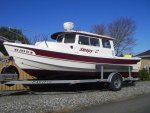drbridge
Member
- Joined
- Jun 25, 2014
- Messages
- 229
- Reaction score
- 8
- C Dory Year
- 2004
- C Dory Model
- 22 Cruiser
- Vessel Name
- Susan Marie
Here is my take on the subject. I have a trailer with the oil hubs and one with the bearing buddy grease hubs. With the grease hubs I take them apart once a year to know that every thing inside is in good condition and that there has been no salt water intrusion that would cause rapid decay of the bearings. This is a PIA of a job to do.
With the oil bath bearings, that incidentally are the same system that are used on front axles of most big rig Semi's on the road today. I can see the oil through the hub. If there is water intrusion it is easy to see. Mine have had some water intrusion a couple of times and in that case I have drained them , flushed them, and refilled them with out removing the hub. I have taken the bearings apart a couple of times in the ten years I have owned the trailer just to check. They were in pristine condition both times and I am still using the original bearings on that trailer. After the last time I pulled all four hubs off the c-dory trailer and cleaned and regreased them, I am convinced that the next time it will be to convert them to the oil bath bearings. I have also had the bearing buddy's on other trailers in the past and I have found evidence of water intrusion enough times that I feel I must take them apart for inspection annually. Sometimes when I do this inspection I find that there is no water intrusion and I have gone to the trouble to take them apart for no reason other than the fact that I can not tell with out taking them apart.
Bottom line for me is that the Bearing buddy's will work , but require a lot more maintenance for me to feel confident that I am running on good bearings. The oil bath always allow me to see what is going on and give me a lot more confidence with less maintenance/labor.
With the oil bath bearings, that incidentally are the same system that are used on front axles of most big rig Semi's on the road today. I can see the oil through the hub. If there is water intrusion it is easy to see. Mine have had some water intrusion a couple of times and in that case I have drained them , flushed them, and refilled them with out removing the hub. I have taken the bearings apart a couple of times in the ten years I have owned the trailer just to check. They were in pristine condition both times and I am still using the original bearings on that trailer. After the last time I pulled all four hubs off the c-dory trailer and cleaned and regreased them, I am convinced that the next time it will be to convert them to the oil bath bearings. I have also had the bearing buddy's on other trailers in the past and I have found evidence of water intrusion enough times that I feel I must take them apart for inspection annually. Sometimes when I do this inspection I find that there is no water intrusion and I have gone to the trouble to take them apart for no reason other than the fact that I can not tell with out taking them apart.
Bottom line for me is that the Bearing buddy's will work , but require a lot more maintenance for me to feel confident that I am running on good bearings. The oil bath always allow me to see what is going on and give me a lot more confidence with less maintenance/labor.

